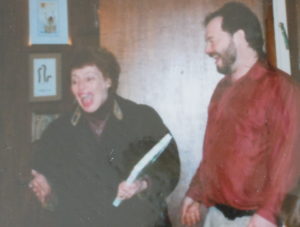Recently, a reporter asked questions about diversity and the environmental movement. I spent a long time responding because I wanted to share it (with slight adaptations) with you, too. Here we go:
1. If possible, could you explain why diversity is so important
for the environmental movement?
2. Climate change hurts all living things, but there are issues
that specifically hurt people who aren’t white, straight,
privileged. What are these issues, and what organizations
actually work to make these issues well-known, and matter?
From New Orleans’ Lower 9th Ward (flooded by Katrina) to the Maldives Islands, people of color bear more of the risk. In many cases, they have the least to do with causing climate change, so there’s a huge justice issue.
It’s harder to make the connections between climate change and LGBT organizing, but here’s one: pressure to be in procreating hetero relationships may cause some people to have children (or have more children). This pressure to “be fruitful and multiply” was probably a huge factor in religious messages against nontraditional lifestyles (such as the wretched passages in Leviticus that have caused so much misery and suffering for thousands of years)—but at the time the Old Testament was written, small bands of humans needed aggressive population growth. Not anymore. Reducing population growth is an obvious way to lower the temperature. Thus, freedom to choose whether to have children becomes a climate issue.
A stronger connection comes back to intersectionality. No one is free when any group is oppressed. Lesbians and trans people especially have been heavily involved in justice issues generally (the push to find a cure for AIDS was largely lesbian-driven, even though they themselves had lower risk than either gay male or hetero folks), including the climate change movement. By working toward healing the planet, they help liberate themselves too.
[I also connected this journalist with Majora Carter in the Bronx and Van Jones in Oakland—two of the most effective activists doing environmental/climate change organizing within communities of color.]
3. In general, could you explain why an inclusive environmental
org staff is one of the most important assets an environmental
organization, and the movement, can have?
- People respond best to those they see as like them. If an organization only has white, economically comfortable, straight staffers, it be a lot tougher to organize in the communities that need it most.
- As a movement, we are much stronger in diversity. Working with people of different backgrounds and cultures lets issues surface and be addressed. A white person from the suburbs may not analyze a situation the same way as a person of color from an inner city neighborhood. By recognizing the value of many different perspectives, solutions arise that are more holistic and more likely to be implemented. As a child growing up in NYC, I never thought about community food self-sufficiency until my teens. People who grew up in the farm community where I live now have been living and breathing it their whole lives. But I knew a lot about mass transit, housing density, and other things that are out of the context of my rural neighbors where I live now.
- We need to walk our talk around inclusiveness and intersectionality—and show up for other communities when they need us. Not just so they show up for us, but because it’s the way the world should work.
It’s from intersectionality that I really developed the work I do, moving business forward on climate change and on hunger, poverty, and peace by showing them how it is in their economic self-interest. As a profitability consultant for green and social entrepreneurship businesses–and author of 10 books, most recently Guerrilla Marketing to Heal the World (endorsed by Seth Godin, Chicken Soup’s Jack Canfield, and many others), I show businesses how they can go beyond mere “sustainability” (keeping things the same) to “regenerativity” (making things better). I work with them to develop and market profitable products and services that turn hunger and poverty into sufficiency, war into peace, and catastrophic climate change into planetary balance.
And as an activist, my proudest campaigns include my (only) arrest at Seabrook in 1977 (the action that pretty much ended the drive toward nuclear power) and founding the movement that saved a local mountain here in Western Massachusetts. I was an early adopter of intersectionality and have been making connections between movements for more than 40 years, starting with connecting student liberation and the Vietnam peace movement as a high school student in NYC. I was raised in a low-income household and have worked for both social justice and environmental causes since 1969 (at age 12). Several years of my life were focused on LGB activism (T wasn’t really on the radar yet). I was on the organizing committee for our local Pride March for three years until they threw the bisexuals out, and my wife and I still march in this parade almost every year. In my 20s, I even had a VISTA job as an organizer for the Gray Panthers and immediately brought them into a Brooklyn-wide anti-racist, mixed-class coalition against nuclear power that I co-founded.






